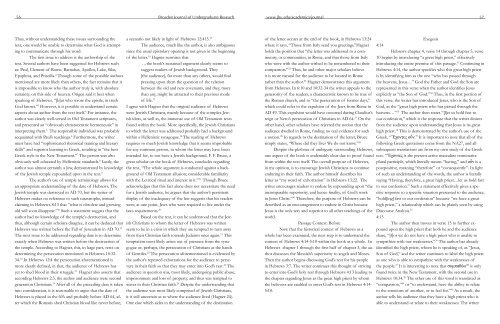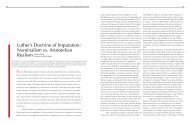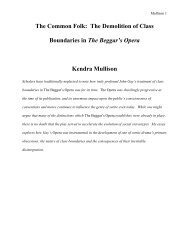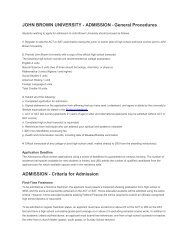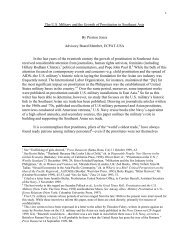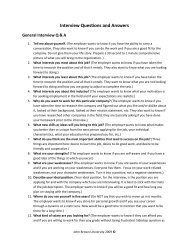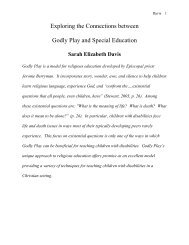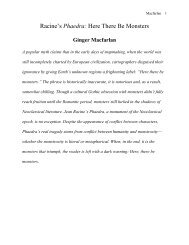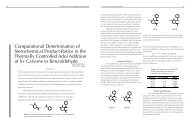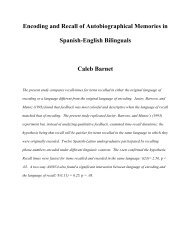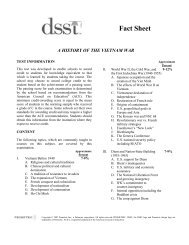Hebrews 4:14-5:10: Jesus, The Great High Priest Patton Shinall
Hebrews 4:14-5:10: Jesus, The Great High Priest Patton Shinall
Hebrews 4:14-5:10: Jesus, The Great High Priest Patton Shinall
- No tags were found...
You also want an ePaper? Increase the reach of your titles
YUMPU automatically turns print PDFs into web optimized ePapers that Google loves.
56 Broaden Journal of Undergraduate Reseachwww.jbu.edu/academics/journal57Thus, without understanding these issues surrounding thetext, one would be unable to determine what God is attemptingto communicate through his word.<strong>The</strong> first issue to address is the authorship of thetext. Several authors have been suggested for <strong>Hebrews</strong> suchas: Paul, Clement of Rome, Barnabas, Apollos, Luke, Silas,Epaphras, and Priscilla. 2 Though some of the possible authorsmentioned are more likely than others, the fact remains that itis impossible to know who the author truly is, with absolutecertainty, on this side of heaven. Origen said it best whenspeaking of <strong>Hebrews</strong>, “[b]ut who wrote the epistle, in truthGod knows.” 3 However, it is possible to understand certainaspects about author from the text itself. 4 For instance, theauthor was clearly well-versed in Old Testament scriptures,and presented an “obviously christocentric hermeneutic” ininterpreting them. 5 <strong>The</strong> responsible individual was probablyacquainted with Paul’s teachings. 6 Furthermore, the writermust have had “sophisticated rhetorical training and literaryskills” and superior learning in Greek, resulting in “the bestGreek style in the New Testament.” 7 <strong>The</strong> person was alsoobviously well educated by Hellenistic standards. 8 Lastly, theauthor was almost certainly a Jew, demonstrated by knowledgeof the Jewish temple expounded upon in the text. 9<strong>The</strong> author’s use of temple terminology allows foran appropriate understanding of the date of <strong>Hebrews</strong>. <strong>The</strong>Jewish temple was destroyed in AD 70, but the writer of<strong>Hebrews</strong> makes no reference to such catastrophe, insteadclaiming in <strong>Hebrews</strong> 8:13 that “what is obsolete and growingold will soon disappear.” <strong>10</strong> Such a statement suggsts that theauthor had no knowledge of the temple’s destruction, andthus, although certain scholars disagree, it can be deduced that<strong>Hebrews</strong> was written before the Fall of Jerusalem in AD 70. 11<strong>The</strong> next issue to be addressed regarding date is to determineexactly when <strong>Hebrews</strong> was written before the destruction ofthe temple. According to Hagner, this, in large part, rests ondetermining the persecution mentioned in <strong>Hebrews</strong> <strong>10</strong>:32-34. 12 In <strong>Hebrews</strong> 12:4 the persecution aforementioned ismore clearly defined, in that, the audience of <strong>Hebrews</strong> hasyet to shed blood in their struggle. 13 Hagner also asserts thataccording <strong>Hebrews</strong> 2:3, the author and audience were secondgeneration Christians. <strong>14</strong> After all of the preceding data is takeninto consideration, it is reasonable to argue that the date of<strong>Hebrews</strong> is placed in the 60’s and probably before AD 64, afterwhich the Romans shed Christian blood like never before,a scenario not likely in light of <strong>Hebrews</strong> 12:415. 15<strong>The</strong> audience, much like the author, is also ambiguoussince the usual epistolary opening is not given in the beginningof the letter. 16 Hagner surmises that…the book’s sustained argument clearly seems tosuggest readers of Jewish background. <strong>The</strong>y[the audience], far more than any others, would findpressing upon them the question of the relationbetween the old and new covenants, and they, morethan any, might be attracted to their previous modeof life. 17I agree with Hagner that the original audience of <strong>Hebrews</strong>were Jewish Christians, mainly because of the complex Jewishideas, as well as, the immense use of Old Testament textsfound within the book. More specifically, the Jewish Christiansto which the letter was addressed probably had a backgroundwithin a Hellenistic synagogue. 18 <strong>The</strong> reading of <strong>Hebrews</strong>requires so much Jewish knowledge that it seems improbablefor any common person, to whom the letter may have beenintended for, to not have a Jewish background. F. F. Bruce, agreat scholar on the book of <strong>Hebrews</strong>, concludes regardingthe text, “<strong>The</strong> whole argument is conducted against a backgroundof Old Testament allusion; considerable familiaritywith the Levitical ritual and interest in it.” 19 Though Bruceacknowledges that this fact alone does not necessitate the needfor a Jewish audience, he argues that the author’s persistentdisplay of the inadequacy of the law suggests that his readerswere, at one point, Jews who were required to live under thelaws requirements. 20Based on the text, it can be understood that the JewishChristians to whom the letter of <strong>Hebrews</strong> was writtenseem to be in a crisis in which they are tempted to turn awayfrom their Christian faith towards Judaism once again. 21 Thistemptation most likely arises out of pressure from the synagogueor, perhaps, the persecution of Christians at the handsof Gentiles. 22 <strong>The</strong> persecution aforementioned is evidenced bythe author’s repeated exhortations for the audience to perseverein their faith so that they may enter into God’s rest. 23 <strong>The</strong>audience in question was, most likely, undergoing public abuse,imprisonment and loss of property, and thus was tempted towaver in their Christian faith. 24 Despite the understanding thatthe audience was most likely comprised of Jewish Christians,it is still uncertain as to where the audience lived (Hagner 24).One clue which aides in the understanding of the destinationof the letter occurs at the end of the book, in <strong>Hebrews</strong> 13:24where it says, “Those from Italy send you greetings.”Hagnerholds the position that “the letter was addressed to a community,or communities, in Rome, and that those from Italywho were with the author wished to be remembered to theircompatriots.” 25 Thus, he and other major scholars believeit is more natural for the audience to be located in Romerather than the author. 26 Hagner demonstrates this argumentfrom <strong>Hebrews</strong>. In 6:<strong>10</strong> and <strong>10</strong>:32-34 the writer appeals to thegenerosity of the readers, a characteristic known to be true ofthe Roman church, and to “the persecution of former days,”which could refer to the expulsion of the Jews from Rome inAD 49. This expulsion would have occurred during Claudius’sreign or Nero’s persecution of Christians in AD 64. 27 On theother hand, other scholars have rejected the notion that theaudience dwelled in Rome, finding no real evidence for sucha notion. 28 In regards to the destination of the letter, Brucesimply states, “Where did they live? We do not know.” 29Despite the plethora of ambiguity surrounding <strong>Hebrews</strong>,one aspect of the book is undeniably clear due to proof foundfrom within the text itself. <strong>The</strong> overall purpose of <strong>Hebrews</strong>,in my opinion, is to encourage Jewish Christians to continueenduring in their faith. <strong>The</strong> author himself describes hisletter as “my word of exhortation” in <strong>Hebrews</strong> 13:22. <strong>The</strong>writer encourages readers to endure by expounding upon “theincomparable superiority, and hence finality, of God’s workin <strong>Jesus</strong> Christ.” 30 <strong>The</strong>refore, the purpose of <strong>Hebrews</strong> can bedescribed as an encouragement to endure in Christ because<strong>Jesus</strong> is the only way and superior to all other teachings of theworld.Passage Context: BeforeNow that the historical context of <strong>Hebrews</strong> as awhole has been examined, the next step is to understand thecontext of <strong>Hebrews</strong> 4:<strong>14</strong>-5:<strong>10</strong> within the book as a whole. In<strong>Hebrews</strong> chapter 1 through the first half of chapter 3, the authordiscusses the Messiah’s superiority to angels and Moses.<strong>The</strong>n the author begins discussing God’s rest for his peoplein <strong>Hebrews</strong> 3:7. <strong>The</strong> writer continues this thought of strivingto enter into God’s holy rest through <strong>Hebrews</strong> 4:13 leading tothe chapter regarding <strong>Jesus</strong> as the great high priest by whomthe believers are enabled to enter God’s rest in <strong>Hebrews</strong> 4:<strong>14</strong>-5:<strong>10</strong>.Exegesis4:<strong>14</strong><strong>Hebrews</strong> chapter 4, verse <strong>14</strong> through chapter 5, verse<strong>10</strong> begins by introducing “a great high priest,” effectivelyintroducing the entire premise of this passage. 31 Continuing in<strong>Hebrews</strong> 4:<strong>14</strong>, the author specifies who this great high priestis by identifying him as the one “who has passed throughthe heavens, <strong>Jesus</strong>…” God the Father and God the Son arerepresented in this verse when the author identifies <strong>Jesus</strong>explicitly as “the Son of God.” 32 Thus, in the first portion ofthis verse, the writer has introduced <strong>Jesus</strong>, who is the Son ofGod, as the “great high priest who has passed through theheavens…” 33 <strong>The</strong> author then states “[l]et us hold fast toour confession,” which is the response that the writer desiresfrom the audience upon understanding that <strong>Jesus</strong> is its greathigh priest. 34 This is demonstrated by the author’s use of theGreek, “Ἔχοντες οὖν.” It is important to note that all of thefollowing Greek quotations come from the NA27, and allsubsequent translations are from my own study of the Greektext. “Ἔχοντες is the present active masculine nominativeplural participle, which literally means “having,” and οὖν is apostpositive, meaning “therefore” or “consequently”. In lightof such an understanding of the words, the author is literallysaying “Having, therefore, a great high priest…let us hold fastto our confession.” Such a statement effectively gives a specificresponse to a specific situation presented to the audience,“hold[ing] fast to our confession” because “we have a greathigh priest,” a relationship which can be plainly seen by usingDiscourse Analysis. 354:15<strong>The</strong> author then moves in verse 15 to further expoundupon the high priest that both he and the audienceshare, “[f]or we do not have a high priest who is unable tosympathize with our weaknesses.” 36 <strong>The</strong> author has alreadyidentified the high priest, whom he is speaking of, as “<strong>Jesus</strong>,Son of God,” and the writer continues to label the high priestas one who is able to sympathize with the weaknesses ofthe people. 37 It is interesting to note that συμπαθέω 38 is onlyfound twice in the New Testament, with the second use in<strong>Hebrews</strong> <strong>10</strong>:34. 39 <strong>The</strong> other use of this word is translated as“compassion,” 40 or “to understand, have the ability to relateto the emotions of another, or to feel for.” 41 As a result, theauthor tells his audience that they have a high priest who isable to understand or relate to their weaknesses. <strong>The</strong> writer


